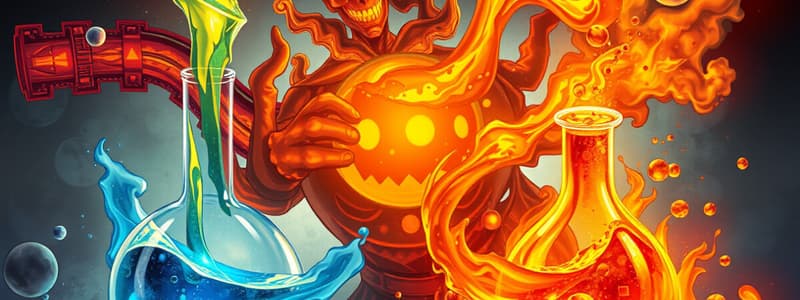Podcast
Questions and Answers
What three criteria classify chemical reactions?
What three criteria classify chemical reactions?
Changes in chemical structure, changes in chemical energy, and whether it is irreversible or reversible.
What is the type of reaction represented by AB --> A+B?
What is the type of reaction represented by AB --> A+B?
Decomposition reaction
What is a decomposition reaction?
What is a decomposition reaction?
A large molecule is digested or broken down into smaller structures.
Give an example of a decomposition reaction.
Give an example of a decomposition reaction.
What is the definition of a synthesis reaction?
What is the definition of a synthesis reaction?
Give an example of a synthesis reaction.
Give an example of a synthesis reaction.
What is an exchange reaction?
What is an exchange reaction?
Provide an example of an exchange reaction.
Provide an example of an exchange reaction.
What are oxidation-reduction reactions?
What are oxidation-reduction reactions?
What occurs during oxidation?
What occurs during oxidation?
What occurs during reduction?
What occurs during reduction?
Is NAD+ oxidized or reduced when it becomes NADH? Explain.
Is NAD+ oxidized or reduced when it becomes NADH? Explain.
Provide an example of oxidation-reduction reactions.
Provide an example of oxidation-reduction reactions.
What does LEO stand for?
What does LEO stand for?
What does GER stand for?
What does GER stand for?
What are exergonic reactions?
What are exergonic reactions?
Provide an example of an exergonic reaction.
Provide an example of an exergonic reaction.
What are endergonic reactions?
What are endergonic reactions?
Provide an example of an endergonic reaction.
Provide an example of an endergonic reaction.
What is ATP cycling?
What is ATP cycling?
What type of reaction is ATP formation?
What type of reaction is ATP formation?
What type of reaction is ATP splitting?
What type of reaction is ATP splitting?
What is an irreversible reaction?
What is an irreversible reaction?
What is a reversible reaction?
What is a reversible reaction?
Provide an example of a reversible reaction.
Provide an example of a reversible reaction.
For a chemical reaction that involves simple chemical structures bonded together into a more complex molecule, choose the more accurate term in each pair: (a) Synthesis or decomposition reaction; (b) Exergonic or endergonic reaction; (c) collective term for this type of reaction (catabolism or anabolism).
For a chemical reaction that involves simple chemical structures bonded together into a more complex molecule, choose the more accurate term in each pair: (a) Synthesis or decomposition reaction; (b) Exergonic or endergonic reaction; (c) collective term for this type of reaction (catabolism or anabolism).
What molecule is formed from exergonic reactions and used as the energy currency for endergonic reactions?
What molecule is formed from exergonic reactions and used as the energy currency for endergonic reactions?
Explain what occurs when the equilibrium is disturbed in reversible reactions by changes in reactants and products.
Explain what occurs when the equilibrium is disturbed in reversible reactions by changes in reactants and products.
Flashcards are hidden until you start studying
Study Notes
Classification of Chemical Reactions
- Chemical reactions are classified by changes in chemical structure, energy, and whether they are reversible or irreversible.
Decomposition Reaction
- Characterized by the breakdown of a large molecule into smaller components.
- Example includes sucrose (disaccharide) breaking down into glucose.
Synthesis Reaction
- Involves combining two or more atoms, ions, or molecules to form a new compound.
- Example is the formation of a dipeptide from amino acids.
Exchange Reaction
- Atoms, molecules, ions, or electrons are exchanged between two chemical structures.
- Example is the reaction of creatine phosphate with ADP to form creatine and ATP.
Oxidation-Reduction Reactions (Redox)
- These reactions involve the transfer of electrons between chemicals.
- Oxidation occurs when a chemical loses electrons; reduction occurs when it gains electrons.
Electron Transfer and NAD+
- NAD+ is reduced to NADH upon gaining electrons (2e- and H+).
Mnemonics
- LEO: "Loses Electrons is Oxidized."
- GER: "Gains Electrons is Reduced."
Exergonic Reactions
- Reactions that release chemical energy.
- Example: Decomposition of glucose into carbon dioxide and water.
Endergonic Reactions
- Reactions that require energy input to proceed.
- Example: Formation of a dipeptide from two amino acids.
ATP Cycling
- Continuous process of ATP formation (endergonic) and splitting (exergonic).
Reactions' Nature
- Irreversible reactions lead to a net gain in products and loss in reactants.
- Reversible reactions achieve a balance with no net change in concentrations of reactants or products.
Example of Reversible Reaction
- CO2 + H2O to H2CO3 (with dissociation to H+ and HCO3-) demonstrates dynamic equilibrium.
Reaction Dynamics
- Disturbances in equilibrium conditions affect reaction rates, leading to an increase or decrease in products or reactants based on the limiting factor.
Energy Currency in Cells
- ATP is the primary energy currency formed from exergonic reactions, driving endergonic processes.
Studying That Suits You
Use AI to generate personalized quizzes and flashcards to suit your learning preferences.




